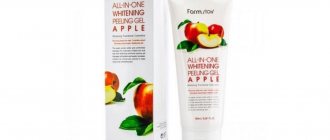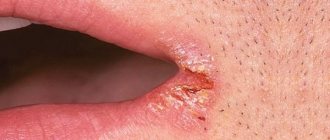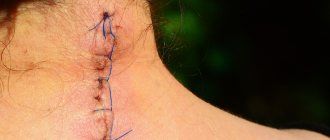From this article you will learn:
- keloid scar and hypertrophic scar - what is the difference,
- laser resurfacing of scars: before and after photos, video,
- what is the best ointment for scars?
A keloid scar is the result of excessive growth of scar tissue. It looks like a hard, smooth, tough, nodular growth, often in various shades of red. Many people mistakenly refer to it as “colloidal scar,” which is a grammatically incorrect name.
Keloid scars (keloids) can begin to form immediately after injury or several months later. They can be significantly larger than the original wound itself. Unlike other types of scars, this type of scars/scars never lighten or become invisible over time.
Keloid scar: photo
They occur on any part of the body where there has been damage to the skin, but the following parts of the body are most susceptible to the formation of keloids: chest, shoulders, neck, knees, ankles, earlobes.
Keloid scar and hypertrophic scar - what is the difference?
Usually, after an injury, the body starts the healing process, as a result of which a regular flat scar forms on the surface of the skin (at the site of the former wound). For reasons still unknown to science, the scar may suddenly begin to thicken, i.e. hypertrophy of scar tissue occurs. Hypertrophy can be of two types, and depending on its type, either a hypertrophic scar or a keloid scar occurs.
- Hypertrophic scar (Fig. 7-9) - is formed if hypertrophy is limited to the area and size of the wound itself.
Most often, hypertrophic scars begin to develop within the first two months after injury, and quickly turn red. The growth occurs for up to 6 months, after which spontaneous regression usually occurs (it stops growing or even decreases slightly). This whole process usually takes 1 year, no more. Timely treatment (cortisone injections or steroids) can speed up the regression process. - Keloid scar (Fig. 1-6) - if the hypertrophy of scar tissue extends beyond the area of skin damage, capturing healthy undamaged tissue - such a scar is called keloid.
This type of scar develops over several years after injury, but can sometimes occur completely spontaneously even without previous injury, such as on the chest. A keloid scar can grow for many years and never regresses like a hypertrophic scar. Moreover, keloid scars often grow again if they were previously removed surgically. This never happens with hypertrophic scars (24stoma.ru).
Other symptoms of keloid scars are:
Keloid scars can be either flesh-colored or red, pink, or darker colors. They can be smooth, nodular or spherical, or simply protrude above the skin in lumps. If the keloid is exposed to sunlight during the first year of formation, the scar may permanently become darker than the surrounding skin. Sometimes a keloid scar will cause itching, irritation, or pain (and these symptoms may be worsened by rubbing clothing).
Scars
Scars are the common name for scars. Scars are the result of replacement of the skin's own tissues with connective tissue as a result of various damages: mechanical stress, temperature (scars form after burns), skin diseases (so-called post-acne).
The problem of scars is common to both dermatologists and cosmetic surgeons. Each of these specialists deals with this problem. Scars are not as simple as they seem at first glance. There are many subspecies and groups. For example, it is important to distinguish between physiological scarring and pathological scarring.
Physiological is when, after an injury, the scar gradually turns pale and becomes compact. And sometimes the reverse process suddenly begins - the scar enlarges, becomes brighter, turns red or blue. In this case, pathological scarring develops, and then the intervention of a specialist is necessary to make a decision on correcting the process.
Physiological scarring has three stages.
Stage 1 - fibroblastic - lasts up to 30 days, it is characterized by the appearance of young fibroblasts and an abundance of blood vessels.
Stage 2 - fibrous - is formed by the 33rd day from the moment of injury; characterized by the presence of mature fibroblasts and the accumulation of fibrous structures in the scar tissue, primarily collagen fibers.
Stage 3 - hyaline - is formed by the 42nd day; characterized by a decrease in the number of cells and vessels.
It is very important to understand at what stage of scar formation you went to the doctor. The success of treatment largely depends on the time the problem appears: the sooner the better. There is a misconception that you can get rid of scars forever. No, It is Immpossible. The surgeon can improve the quality of the scar. Imagine that the scar is wide and rough. An experienced surgeon can make it thinner and less noticeable. It will excise excess skin and “form” a new, but more beautiful scar. Cosmetologists and dermatologists can recommend a complex of treatment for scars depending on their types.
A scar can occur after injury, surgery, or piercing and is the result of closing a tissue defect with newly formed connective tissue. If the damage affects only the epidermis, then no traces remain, since the cells of the basal layer of the epidermis retain the ability to fully regenerate throughout life.
If the damage affects the deeper layers of the skin (dermis), then the tissue defect is filled with granulation tissue, which subsequently forms into a scar. During the normal course of the scarring process, the scar tissue gradually flattens and acquires the color of the surrounding tissues (normotrophic scar). If the course of the process is disrupted, then there is a high probability of the formation of pathological scars.
It is very important to correctly determine the type of scar to determine the duration and choice of treatment method.
Scars are:
- Normotrophic scars are flush with the surrounding skin;
- Atrophic - a hole in the skin that forms when there is a lack of connective tissue;
- Hypertrophic – protruding above the surface of the skin;
- Keloids are a hard fibrous growth. Unlike a hypertrophic scar, it extends beyond the boundaries of the former wound and over time not only does not decrease, but in certain cases it can increase its area.
Normotrophic scars are flush with the surrounding skin, pale or flesh-colored, and have an elasticity similar to that of normal tissue. They most often do not bother the patient. As a rule, it is not recommended to treat them radically, that is, resort to surgery. But this does not mean that they should not be dealt with. With the help of microdermabrasion or superficial (sometimes medium) chemical peels, these scars can be made almost invisible.
Atrophic scars are located below the level of the surrounding skin and are characterized by sagging tissue. A typical example of atrophic scars are stretch marks (stretch marks). There are many treatments for this type of scar. Moreover, it should be noted that with persistent and correct treatment, almost all patients are satisfied with the aesthetic result.
Hypertrophic scars protrude above the surface of the skin, are limited to the injured area and spontaneously regress within two years, although the regression may be incomplete. The color of such scars is usually pink. This type of scar is highly treatable and does not recur.
The best cosmetic result is achieved with surgical treatment - excision of scar tissue. If the scar is small, it can be treated well with peelings - chemical, microdermabrasion, laser resurfacing. Among conservative methods, good results are achieved through electro- and ultraphonophoresis with hydrocortisone, lidase, contractubex or injections of hormonal drugs into the scar area, such as diprospan or kenalog.
Keloid scars can be star-shaped or fan-shaped, have the appearance of linear cords, usually protrude above the skin level and have a sharp border. Often accompanied by itching, pain, burning. They are characterized by the ability to constantly grow and recur after treatment, as a result of which the size of the scar can be several times greater than the size of the wound. Treatment of keloid scars still remains one of the most challenging tasks; treatment effectiveness and recurrence rates are highly variable.
Removal of scars (scars) with laser.
At our clinic we offer a modern approach to scar correction.
The program is always compiled individually, taking into account your characteristics and severity of the problem.
To correct normotrophic scars, the following are used:
- Microcurrent therapy to normalize skin color.
- Skin polishing with ER:YAG laser Fotona to even out the light reflection of scar tissue and surrounding tissue.
To correct hypertrophic scars:
Laser treatment for scars
- To reduce the area of scars - deep fractional resurfacing of scar tissue ER: YAG with a Fotona laser.
- To remove excess scar tissue in height - laser resurfacing over an area with a full ER:YAG beam using a Fotona laser
- Combined treatment methods – combinations of planar and fractional ER:YAG laser treatment with Fotona laser within one procedure.
- Intraruminal administration of drugs is an effective method of reducing scar volume, inhibits growth and causes regression of hypertrophic and keloid scars.
To correct atrophic scars:
- All types of combined use of laser technologies;
- Contouring using hyaluronic acid fillers to correct areas of minus tissue.
- PRP therapy.
Still have questions? Call!
Sign up for a free consultation with a cosmetologist with digital skin diagnostics. With its help, you can accurately determine the condition of your skin and identify existing problems. Our specialists will conduct a detailed analysis of the data obtained and select the most suitable course of treatment for you, taking into account your individual characteristics.
Our doctors have extensive experience and a light hand! Attention, care and comfort during the procedure are guaranteed!
We recommend
- Cellulite - what is it?
Keloid scars: causes of occurrence
During the wound healing process, fibroblasts begin to actively synthesize collagen. Sometimes, for some reason, fibroblasts begin to produce more collagen than is necessary for the normal wound healing process. In this case, the scar begins to grow, forming a keloid. According to studies, collagen synthesis in keloid scars is 20 times higher than in normal scars.
Keloids can develop from a variety of skin injuries, including - → surgical incisions, → wounds on the skin after injury, → vaccination injections, → acne (pimples and pimples), chicken pox, → piercings of various parts of the body (including piercings of the earlobes).
Surgical removal of scars and scars –
It is much easier to prevent the appearance of keloid scars by using special ointments or silicone patches than to treat scars that have already appeared.
Surgical treatment consists of excision of the keloid scar using a scalpel or surgical laser. Surgical removal of scars with a laser should not be confused with the procedure of laser resurfacing of scars. The latter is a conservative non-surgical procedure. However, for keloid scars, surgical treatment methods are quite risky, because the operation may cause the formation of a similar or even larger keloid in the place of the previous one. Therefore, if excision is nevertheless used, then immediately after the operation all possible preventive measures are used to avoid relapse -
→ special ointments for scars, → corticosteroid drugs, → long-term wearing of a pressure bandage or compression garments after surgery.
Excision of a keloid using a surgical laser: video
How to get rid of the problem
When treating scars, it is advisable to contact a specialist at the earliest stages. Exclusively home treatment, especially with deep skin fibrosis, can worsen the condition and course of the disease. In addition, loss of time for full treatment always aggravates the pathological process.
At home
Home treatment for fibrous scarring helps either in the first stages of compaction formation, or as an auxiliary method in complex medical treatment.
It is forbidden:
- rub the scar with plant materials, including celandine;
- intensively massage the formation without consulting a doctor;
- squeeze out suspicious formations;
- irradiate the affected area with ultraviolet light, sunbathe, visit a sauna, bathhouse.
Massage
Convex scars can be softened through gentle massage after lubricating the seal with medicated anti-scar ointments. The optimal number of massage repetitions is 3 times a day.
Massage techniques are performed with 2 and 3 fingers 10 times:
- Along the contour of the scar, make 10 circles to the right and 10 to the left.
- Alternate the circle to the right and immediately to the left (10 times).
- Zigzag downward movement.
- Zigzag up.
- Combine zigzags down and up, alternating movements.
- “Eight” to the right and then to the left (10 times each).
- The figure-of-eight combination is left-right.
- Vibrating movements with gentle pressure connected by the ring and middle fingers.
Each technique should be repeated at least 10 times. After the massage, it is advisable to apply a light-pressure bandage made of natural fabric to the scar for half an hour.
Oils and masks
If scar fibrosis of the skin is diagnosed, you should use cosmetics and masks that moisturize and nourish the dermis, smoothing the surface of the skin. Such products should contain fruit acids, lipids, vitamin E, F, and retinol. It is advisable to use masks with natural oils in the absence of allergies: grape seed oil, jojoba, peach, wheat germ. As a rule, they are used for a long time as part of complex treatment of scars.
If the scars are located on open areas of the body, it is necessary to use ultraviolet radiation creams with a protection level of SPF 30 or higher for a year. This reduces the risk of skin hyperpigmentation in the scar area.
Drugs
The pharmacy chain offers many anti-scar external products in the form of creams, gels, sprays, ointments, but in each specific case a competent selection is necessary, so it is advisable to consult a dermatologist.
Experts insist that the effect of external agents is fully manifested only when treating young scars (up to 12 months). This can prevent further growth of scar tissue and reduce pigmentation, itching and redness.
Old fibrosis is treated using injections, hardware cosmetology, laser and cryotherapy, and surgical interventions. Local medications help with mature scar cords, but only as an addition to the main therapy to soften, reduce the size and height of the scar, and lighten it.
The most effective ointments and gels:
- Contractubex . Reduces the proliferation of fibrous fibers and has a pronounced anti-inflammatory effect. It is used in the treatment of various types of scars. To enhance the therapeutic effect, Contractubex is used in combination with physiotherapy. It is allowed to apply the gel to steamed skin. For old scars, the gel is applied in the evening under an airtight bandage. Treatment can last up to six months.
- Fermenkol . Destroys excess collagen fibers that make up raised scars. It consists of enzymes that suppress collagen production, making it effective in the treatment of mature scars (over 6 years old). For maximum effect, it is advisable to use this cream together with electrophoresis.
- Mederma . Helps in the resorption of cosmetic scars remaining after the removal of skin lesions, tattoos, conglobate acne, and other damage after aggressive chemical or laser peels.
- Alandaza . Natural hyaluronidase in the product softens scar tissue and restores elasticity.
- Imoferase. Stabilized hyaluronidase suppresses excessive growth of connective tissue, increases skin elasticity, reduces hyperpigmentation and swelling in the scar area. Apply only after complete healing of the damage for 4–8 weeks and longer if necessary.
- Egallohit (cream and gel). Prevents the appearance of various types of scars after burns, dermabrasion, peeling, laser resurfacing, and surgical operations. Use for at least 1 – 2 months.
- Dermatix silicone gel. It is used for scars of various types and complexity. Smoothes and softens the dermis, maintains high skin moisture in the scar area, prevents their formation, relieves itching, and skin pigmentation disorders. The course is at least 2 months. Can be used as a basis for compresses.
- Emulgel Emeran . Eliminates swelling, tension, accelerates the resorption of seals. Can be applied under a cotton compress.
- Kelo-cote silicone spray and gel . Used to eliminate the consequences of hypertrophied scar development.
- Skarguard . Contains three valuable components: the hormone hydrocortisone, silicone and vitamin E, due to which it is active on different types of scars.
- Zeraderm-Ultra . The best option for treating facial scars, as it simultaneously protects against ultraviolet radiation and allows the use of makeup.
- Silicone plates or patches for scars - Scarfix (USA), Mepiform (Sweden), Arilis Mepiderm (Russia), Spenko. In essence, the patches are a frozen gel, and it is advisable to begin using them immediately after the wound has healed in order to prevent fibrous compaction and increase blood flow. Silicone sheets help resolve young keloid scars with regular use from 2 to 18 months if used daily for 12 to 24 hours.
Ointment for scars and scars on the face can be prepared at home, as the video below will tell you about:
Treatment without surgery
Several types of treatment for fibrous scar formations are being considered. Since the types of scars are different and have different reasons for their appearance, an individual treatment regimen must be developed for a specific type.
Important! A method that helps get rid of one type of scar may be completely unacceptable when treating another.
Medication
Treatment with medications involves the use of an injection technique, which is based on the introduction of drug solutions under the scar or into its thickness. Pronounced therapeutic results are obtained from solutions of drugs that inhibit the growth of connective tissue:
- glucocorticosteroids (Kenalog, Diprospan). Hormonal agents significantly reduce collagen production and inhibit the formation of scar tissue, relieve the inflammatory process. Traditionally, they are administered at intervals of 3–6 weeks until the maximum effect is achieved: reduction in scar height, leveling, elimination of symptoms of itching and soreness. The effectiveness of this treatment is very high;
- enzymes (Lidase, Fermenkol, Hyaluronidase, Longidase). Enzymes break down hyaluronic acid, which seals fibrous tissue, which reduces scar swelling, softens the seals and makes them flatter, preventing further growth. Hyaluronidase is administered daily or every other day in up to 15 or more injections. If necessary, the course is repeated after 2 months.
The video below will tell you how to prepare a mask for scars and scars on the face:
Physiotherapeutic techniques
Most often used for visual correction of scar defects:
- Phonophoresis is a physiotherapeutic technique for introducing therapeutic agents into scar tissue using ultrasonic waves. Very often, drugs such as Lidaza, Kenalog, Diprospan, Contractubex, Collalysin, Longidaza, Hydrocortisone ointment, Fermencol are used for phonophoresis. Ultrasonic waves promote deep penetration of medicinal substances into tissues and provide:
- softening of fibrous cords;
- improved blood circulation and lymph flow thanks to micromassage;
- stimulation of intercellular metabolism;
- saturation of tissues with oxygen;
- acceleration of redox processes;
- suppression of inflammation and swelling.
- Electrostatic massage . Causes deep vibration of fibrous-scar formations due to the effect of a pulsating electrostatic field on them, which enhances blood microcirculation and softens fibrous fibers.
- LPG massage also softens the structure of scar tissue, which leads to resorption and smoothing of scars.
- Bucca rays , as one of the subtypes of radiotherapy. Ionizing radiation affects the fibrous compaction, causing the destruction of fibroblasts and collagen fibers, and thereby helping to reduce the connective tissue lesion.
- Mesotherapy . Used to eliminate atrophic (depressed) scars. Special fillers (usually with hyaluronic acid) are injected under the scar. Under the influence of medicinal extracts, the synthesis of collagen fibers increases, which are necessary to “raise” the depressed surface of the scar to the level of the skin.
- Photo correction . This is a technique for treating skin fibrosis with a light beam in order to lighten the scar and even out the color of the surrounding skin. As a result of light exposure, the scar softens, acquires a physiological color, becomes less pigmented, and flat. Photocorrection is used for flat and convex, as well as red depressed scars. The number of sessions is determined by the type and “age” of the scar.
- Compression therapy. The compression method helps in the treatment of young hypertrophic and keloid scars up to 1 year old. A special bandage, using external pressure (up to 24 millimeters Hg) on the affected area, stops the development of fibrosis, but to achieve a full result, the pressure bandage must be worn around the clock for 9 to 12 months.
Laser methods
Laser peeling, resurfacing, microdermabrasion are procedures similar in mechanism, which use a laser beam that affects abnormal tissue at a precisely calculated depth. Laser therapy is most effective when correcting deep fibrous scars and keloids.
- As a result of layer-by-layer evaporation of atypical fibrous cells with a laser (erbium, carbon dioxide), the scars are reduced and smoothed out. In this case, adjacent areas of healthy skin are not affected.
- When removing atrophic scars, laser treatment is combined with the injection of fillers with hyaluronic acid and collagen to raise the surface of the depressed scar to the level of the skin.
- The procedure is performed in the cold season to minimize solar radiation and the risk of darkening of the treated area.
- The number of laser scar resurfacing procedures depends on the amount of skin fibrosis: for flat and small hypertrophic scars, sometimes 2–4 sessions, carried out with a break of 3–4 weeks, are sufficient; for voluminous scars, up to 10 procedures may be required with an extended recovery period after each (up to 2 months).
The disadvantages of the method, which are also common to other methods, are the high frequency of re-growth of keloid scars.
Cryodestruction
The therapeutic effect of the destruction of fibrous tissue by a cold agent (usually liquid nitrogen) is especially noticeable when removing hypertrophic scars and fresh keloids.
The cryoagent used to treat the area of skin fibrosis destroys atypical cells using ice crystals that rupture their membranes. Sometimes a positive therapeutic effect is achieved after 1 – 3 procedures. But cryotherapy often leads to depigmentation or, conversely, darkening of the epidermis in the area of influence. A more effective method is the combined use of cryotherapy and hormonal injections.
Non-surgical methods for treating keloids -
In addition to surgical treatment, there are other treatment options that can significantly reduce the size of the keloid and also make it lighter.
Laser resurfacing of scars –
This is one of the common methods of dealing with scars, not only keloids, but also hypertrophic ones. Typically, fractional lasers, argon laser, neodymium laser (YAG), CO2 lasers (carbon dioxide), pulsed dye lasers are used for this. Laser scar resurfacing helps make scars appear flatter and less red. The treatment is safe and not too painful, but several sessions are usually required.
The first video shows laser resurfacing of scars: before and after photos. The second video shows laser resurfacing of keloid scars, combined with steroid injections.
Corticosteroid injections –
Corticosteroids reduce excessive scarring through the following effects: → they reduce fibroblast proliferation and activity, → they reduce collagen synthesis, → they reduce the synthesis of glycosaminoglycans, → they reduce the synthesis of inflammatory mediators.
The most commonly used corticosteroid is triamcinolone acetonide (TAC) in a concentration of 10 to 40 mg. For best effectiveness, corticosteroids are used in combination with other scar removal methods (especially cryotherapy), which reduces the risk of recurrence by 50-100%.
Cryotherapy –
Liquid nitrogen causes cell damage. Typically, to achieve the desired effect, 1, 2 or 3 freeze-thaw cycles are carried out, each lasting 10-30 seconds. Repeat treatments may be required every 20-30 days. Studies have shown that the effectiveness of this method is 51-74% without relapse within 30 months of follow-up.
Possible side effects – → pain, → permanent depigmentation of the skin at the site of exposure.
Cryotherapy combined with steroid injections: video
Pressotherapy (pressure bandages) –
It has long been known that pressure has a thinning effect on the skin. A reduction in the number of collagen fibers in hypertrophic and keloid scars under pressure dressings has been demonstrated using electron microscopy data.
Compression treatments include point (button) compression, pressure bandages, elastic bandages, special silicone-based patches... Studies have shown that if you use silicone patches (Mepiform, Spenco) from the very beginning, it improves the condition of scars in 60% patients. However, such patches must be worn 24 hours for several months, which is difficult to maintain.
Scar ointment or scar cream –
Almost any modern ointment for resolving scars contains silicone, which (according to recent research) creates an airtight film, which perfectly moisturizes scars, gives them elasticity and softness. And this, in turn, is a good factor for normal healing and the formation of an unnoticeable flat scar.
Example of external remedies for scars -
- Dermatix (silicone + silicon dioxide) – in Fig. 10,
- Kelo-Kot (contains silicone + polysiloxane) – in Fig. 11,
- Zeraderm ultra (silicone + vitamins E and K + coenzyme Q10 + UV filter 15)
- Skargard (silicone + hydrocortisone + vitamin E),
- Fermenkol (contains collagenase of animal origin).
- Contractubex (contains sodium heparin + onion extract + allantoin),
- silicone patches Mepiform, Dermatix, etc. (Fig. 12).
You should start using ointment for scars after surgery only after the suture has healed, that is, the crusts have completely fallen off. Until this time, the crusts can be lubricated with Panthenol, D-Panthenol, Dexpanthenol or other similar products. Keep in mind that under no circumstances should you pick out the crusts yourself; they should fall off on their own!
An unknown photo of Nikolai Rubtsov was found
This was reported by scar specialist, local historian, and poet from Cherepovets Leonid Veresov.
“Dear friends, I hasten to share with you an unknown photograph of Nikolai Mikhailovich Rubtsov, which was posted online by the first secretary of the Writers' Union of Russia Gennady Viktorovich Ivanov. This photograph was given to him by the Avar poet Magomed Akhmedov (Dagestan). The tables are located in the lower buffet of the Central House of Writers. The scars on it were shot with the poet Igor Lyapin. Congratulations on this find!” — wrote Leonid Veresov.
Magomed Akhmedov knew Rubtsov personally and published a number of memoirs about him, in particular, on the portal https://rubtsov-poetry.ru (this is a site entirely dedicated to the life and work of the Vologda poet).
“I first heard the name of the poet Nikolai Rubtsov in September 1974, during my first year at the Literary Institute. M. Gorky in Moscow on Tverskoy Boulevard, 25. In the courtyard of the institute, at the famous monument to Herzen, yesterday's applicants - today's students - gathered and animatedly argued about poetry and poets, and everyone shouted out loud the name of one or another of their favorite poets. Mostly the names of Yevtushenko, Rozhdestvensky, Voznesensky, and Akhmadulina, who were on everyone’s lips at that time, were mentioned. It was a time of pop poetry, and their names thundered, gathering full stadiums of fans,” the author recalls. - Among this, like a stage, student noise and hubbub, someone, now I don’t remember who, somehow quietly, almost guiltily said: “Kolya Rubtsov”... The hum died down. We, village boys and aul children, first heard the name of this poet in our home language - “Kolya Rubtsov”, and from that day he entered my life as a sign of poetic destiny, as a pure spring of the living Russian poetic word.
Akhmedov also cites the famous legend from his student youth, Rubtsov. Once, in the dormitory of the Literary Institute, someone took down all the portraits of the classics that were hanging on the walls. The commandant began to look for the person responsible for the disappearance. One of the hostel halls was locked from the inside. Nikolai Rubtsov answered the knock on the door.
Inside the hall, the poet put all the portraits he had taken in one row, and he sat down in the chair opposite. When asked what he did here, Rubtsov replied: “Nothing. So I gathered my literary comrades... to learn from them. You see, there is no one to talk to, but these are all smart, brilliant people, it’s interesting to talk to them.”
“This fact really happened, and it characterizes the originality of Rubtsov as a person and a poet. Neither in the institute, nor in life, nor in literature did he lack a worthy understanding, and he sought it from the classics. He himself understood them perfectly, I think that the classics of Russian literature would also understand Rubtsov,” writes Magomed Akhmedov.
The poet Igor Lyapin, photographed with Rubtsov, was a famous author of the 70s and 80s. For the book of poems “Not in an Open Field” and the poem “Line of Fate” he became a laureate of the Lenin Komsomol Prize. After graduating from the Literary Institute, he was the head of the poetry editorial office at the Sovremennik publishing house. He worked as deputy editor-in-chief at the publishing house "Soviet Russia" and editor-in-chief at the publishing house "Children's Literature".











